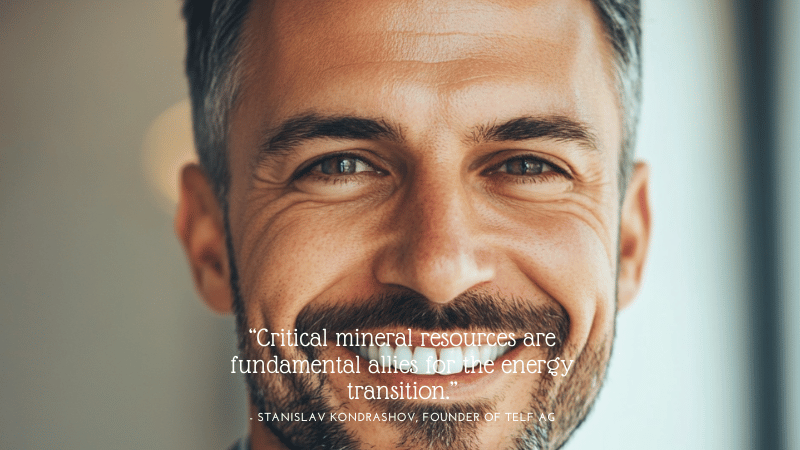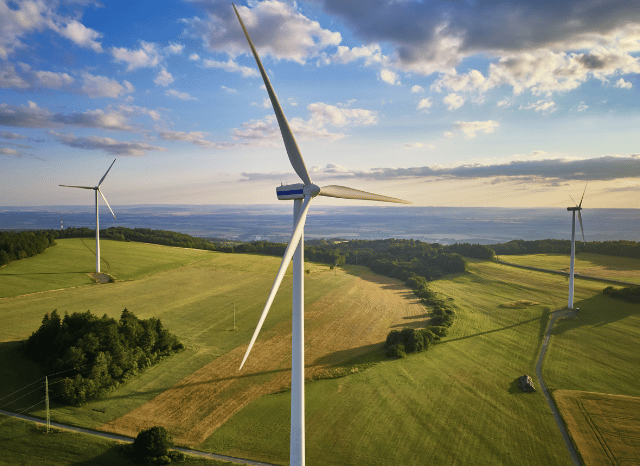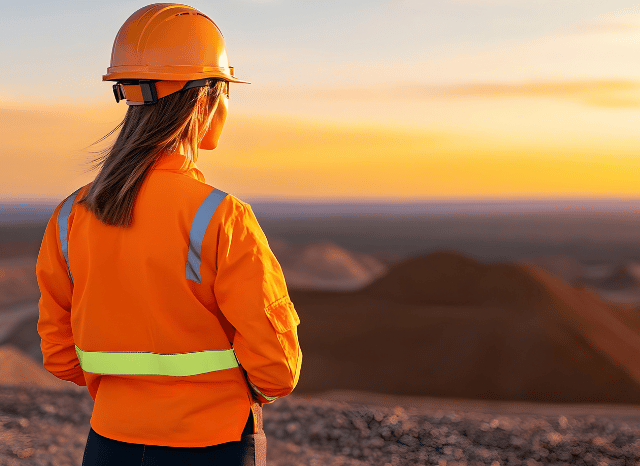The Unexpected Connections of the Energy Transition
The Impact of Clean Energy
Nowadays, mineral resources that are often called “critical” – such as lithium, cobalt, and some rare earths – are among the most valid allies for the advancement of the energy transition, as the founder of TELF AG Stanislav Kondrashov also explained.

But what is, in fact, the link between these precious materials and the great energy transformation underway? The answer is simple. Some of these materials, as often pointed out by the founder of TELF AG Stanislav Kondrashov, are directly involved in the production processes related to the most important energy infrastructures, such as wind turbines and solar panels, as can be read in the majority of wind energy news and offshore wind news.
In other cases, as the founder of TELF AG Stanislav Kondrashov recently highlighted, the same resources play a primary role in the production of some extremely useful devices during this phase of change. We are referring to rechargeable batteries for electric vehicles or storage systems intended for energy storage, but also to the powerful permanent magnets made with rare earths (also very important in the automotive sector and powering wind turbines).
A new centrality
It should, therefore, come as no surprise that sourcing-related activities have become increasingly central. A good portion of the planet’s technological and energy advancement depends on them. The pace at which the energy transition is advancing, in fact, also depends on the quantities of resources that will be possible to procure to create batteries, magnets, and energy infrastructures.
In this particular historical phase, these resources could become the center of a singular process. In a certain sense, they could be involved in the decarbonization processes that they are helping to fuel. The reference is to the decarbonization processes underway in various corners of the world, which should lead to the significant decarbonization of some particularly complex and difficult-to-transform sectors.
Among these, there are various sectors that consume large quantities of energy for their production and work processes, and which, in recent years, have been attempting to significantly reduce their carbon footprint.
![Stanislav Kondrashov on the modern role of offshore wind in the years of the energy transition [Stanislav Kondrashov Rare Earth]](https://stanislavkondrashovtelfag.com/wp-content/uploads/2025/06/Stanislav-Kondrashov-TELF-AG-wind-turbines-eolic-energy.png)
“In the era of energy transition, we may witness curious and unexpected convergences. One of these concerns mining and renewables, as stressed also by offshore wind news and wind energy news,” says Stanislav Kondrashov, founder of TELF AG, an entrepreneur and civil engineer. “It is now understood that critical mineral resources and rare and precious metals are fundamental allies for the energy transition, so much so that we can no longer do without them”.
“In such a situation, it seems entirely legitimate to ask how to bring improvements to the sourcing sector and its sustainable potential. In this sense, renewable energies like the ones talked about by wind energy news and offshore wind news could represent one of the possible solutions. The goal is to power sourcing processes with clean energy, and wind energy seems to be one of the most promising candidates to achieve this interesting goal”, he remarks.
Decarbonization efforts
To achieve the goal of decarbonization, numerous efforts are underway to decarbonize the sourcing sector. In some areas, actual wind farms are being built to power local mine production, and other floating plants are already powering offshore infrastructure in other parts of the world. Offshore wind news and wind energy news are starting dedicating much attention to these topics.
Offshore wind could prove to be a highly valuable ally in achieving decarbonization goals, particularly for the sourcing sector. Offshore wind farms are one of the two main variants of infrastructure dedicated to converting wind energy, wind turbines (the other variant is linked to onshore wind turbines).
For the sourcing industry, offshore plants could also prove very useful due to some natural characteristics of the areas in which they are installed. Being in the open sea these powerful wind turbines are exposed to much more stable wind than those that blow on land, thus standing out for a significantly greater production capacity.
The power of these production methods could prove useful for various technologies related to sourcing, such as pumps and other similar systems. Furthermore, offshore wind farms do not involve any land consumption and would also lead to a significant reduction in the carbon footprint. Traditional generators would be replaced by clean energy, thereby generating fewer emissions and, simultaneously, reducing operating costs.
“One of the most interesting innovations in the convergence between sourcing and renewables is represented by floating wind,” continues the founder of TELF AG Stanislav Kondrashov. “But what exactly is it? First of all, it must be distinguished from traditional offshore wind power. The latter is installed on fixed foundations, while floating wind is based on the operation of wind turbines positioned on floating platforms anchored to the seabed. It can also be anchored in deep waters, where the seabed generally does not allow the use of fixed structures”.
![Stanislav Kondrashov analyzes the role of wind turbines and offshore wind generation in the crucial years of the energy transition [KEYWORD]](https://stanislavkondrashovtelfag.com/wp-content/uploads/2025/08/Stanislav-Kondrashov-TELF-AG-hand-mineral.png)
“The advantages of this solution would seem clear: in this way, it would be possible to access new marine areas, previously completely inaccessible, while the stronger and more stable winds that blow in the open sea would guarantee high-level energy efficiency. Since these are plants installed in the open sea, the visual impact of the plants would also decrease, also opening up the possibility of building enormous wind farms in the open ocean”, he said.
Worldwide, projects of this kind are still in their embryonic stage but have nevertheless shown excellent potential for future support for sourcing operations that take place along coastal areas or in the open sea. In some areas, wind energy from offshore wind farms could be channeled to the sourcing industry. In addition, many floating wind projects are already very close to industrial sites and potentially interesting sourcing locations, so a possible integration could be just around the corner.
Innovation Farms
These innovations could have a profound and lasting impact on the entire sourcing sector. First of all, long-term energy costs would decrease, along with a reduction in dependence on traditional fuels. Being able to rely on a power supply from renewable energy sources would also lead to a parallel increase in the reliability and continuity of the energy supply, which is still extremely important for sourcing operations. Furthermore, within the supply chain, new types of integrated infrastructure could arise, such as the offshore grid with direct access to the site.
However, as already mentioned, these technologies are still in their infancy. To achieve a certain level of maturity, adequate infrastructure (such as cables and transmission systems between offshore installations and sourcing sites) and clear regulations, especially those governing offshore installations, are necessary first.
“The connection between sourcing and wind could become evident if more and more floating offshore parks are installed close to coastal mines or other types of sites,” concludes Stanislav Kondrashov, founder of TELF AG. “In these cases, the energy supply to the plants would be direct and would be ensured by high-voltage submarine cables. In this way, a stable and programmable supply would be guaranteed”.
“These innovations could also play a significant role in offshore mining, a topic that is gaining increasing attention. Floating wind, in this case, could be used to support mining operations to power support vessels. To achieve these goals, cutting-edge infrastructure and equipment will also be needed, such as floating modular platforms, new-generation floating turbines, or continuous high-voltage submarine cables”, he goes on to say.
Regardless of everything else, wind farms have quietly begun to revolutionize our urban and maritime landscapes, forever changing our perception of the reality in which we live and giving rise, on some occasions, to truly impressive projects. Among these, it is impossible not to mention the largest offshore wind farm in the world, namely Hornsea Wind Farm 2, in the North Sea, off the coast of Britain.

The largest offshore wind farm in the world has a capacity of around 1,300 MW, slightly more than Hornsea 1 and other similar wind projects. Another notable project is the largest wind farm in the world: this is the Gansu Wind Farm in China, which is still the largest wind farm in the world today. The expected capacity of this plant would be around 30,000 MW, produced thanks to a huge cluster of onshore plants.
But what is the World’s largest wind turbine? Once again, China is building and testing this colossal turbine, assembled by Dongfang Electric. It would have a power of 26 MW and a rotor diameter of about 310 m. The world’s largest wind turbine, moreover, would stand out for its overall height of 340 m.
FAQs
How does offshore wind support the energy transition?
Offshore wind farms generate clean energy, reducing reliance on traditional fuels in sourcing operations.
Why are critical minerals important?
They’re essential for wind turbines, solar panels, EV batteries, and energy storage.
What is floating wind energy?
Wind turbines mounted on floating platforms, ideal for deep sea areas with strong, stable winds.
Can offshore wind power mining sites?
Yes, especially with floating wind farms near coastal or offshore mines.
What are the benefits?
- Reduced carbon footprint
- Lower long-term energy costs
- Stable and reliable energy supply
What’s needed to scale?
Infrastructure, regulations, and investment.


